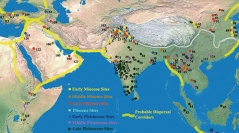

 Comptes Rendus Palevol
15 (7) - Pages 889-902
Comptes Rendus Palevol
15 (7) - Pages 889-902A biostratigraphic evaluation of the Indian subcontinent Neogene–Quaternary mammal genera at 1 Ma intervals reveals a strong correlation between faunal turnovers (first and last appearances and immigrations), diversity and major tectonic and climate-induced sea level and vegetation changes at 23–22, 20–18, 17–16, 15–14, 11–10, 9–8, 3–2 and 1–0 Ma. The Early Miocene collision of Afro-Arabian and Eurasian Plates, followed by the Middle Miocene Climate Optima and the presence of evergreen rainforests, most likely facilitated the dispersals into and out of the subcontinent from the west along the coast and included African proboscideans, primates, creodonts, thryonomyid rodents and Asian chalicotheres, rhinos, suids, anthracotheres, carnivores and muroid rodents. The Late Miocene and Early Pleistocene cooler and drier conditions, the spread of grasslands and sea level drops may have influenced the exchange of African monkeys, Eurasian carnivores, bovids, equids, camelid, and South Asian suids, leporids and murids. Immigrations from the east (East and SE Asia) occurred mostly during the Miocene and involved primarily small mammals.
Indian Subcontinent, Neogene–Quaternary, Mammalia, Dispersal, Paleobiogeography